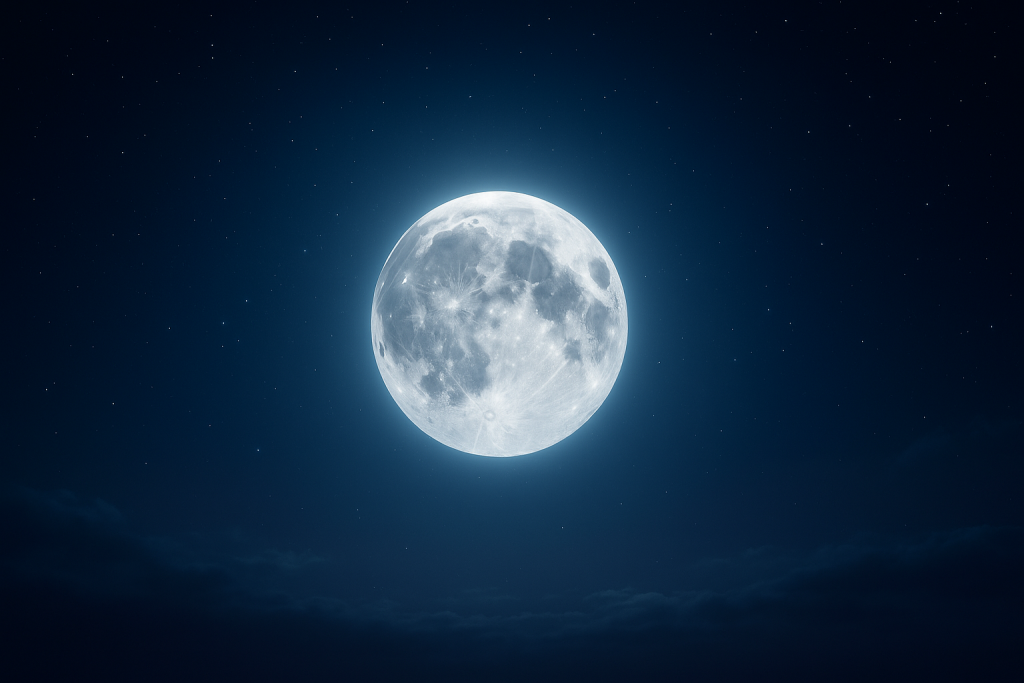Every night, countless people gaze up at the glowing Moon and wonder — why does the moon shine at night when it has no light of its own?
The answer, as explained by scientists from NASA and ISRO, lies in simple physics and cosmic elegance: the Moon shines because it reflects sunlight from the Sun.
That soft glow we see in the sky is not its own light but a gentle reflection of sunlight bouncing off the Moon’s rocky surface, turning the dark night into a calm, silver spectacle.
What Makes the Moon Glow
If you could stand on the Moon, it wouldn’t look bright at all — more like a gray desert made of powder and rock. Yet from Earth it gleams.
This happens because the Moon’s ground acts like a rough mirror. When sunlight falls on it, each grain of dust bounces light in many directions.
According to NASA’s optical studies, this scattered light covers the Moon evenly, giving the illusion of a steady glow.
ISRO’s Chandrayaan missions confirmed that the minerals on the lunar surface reflect light differently, adding subtle shades to what we call moonlight.
The Changing Phases Explain Why Does the Moon Shine at Night
The Moon moves around Earth once every month. As its position shifts, we see different amounts of the sunlit half. That’s what causes its phases.
- When the Moon lies between Earth and the Sun, its bright side faces away — we see almost nothing.
- A week later, a thin curve appears — the crescent Moon.
- When half of it faces us, we call it first quarter.
- When Earth stands between the Sun and the Moon, the visible side is completely lit — the full Moon.
Each shape simply shows how sunlight touches the Moon. So the changing phases are another clue to why the moon shines at night in different ways.
Why the Moon Appears So Bright
In truth, the Moon is quite dark; it reflects only a small slice of the sunlight that hits it. But to our eyes, it seems brilliant.
That illusion comes from three factors:
- Contrast: The blackness of space makes even faint light look strong.
- Distance: At only about 384,000 kilometers away, the Moon’s reflected light reaches us with little loss.
- Geometry: When the Sun’s rays hit the Moon head-on (during a full phase), the light returns almost directly to Earth.
NASA’s brightness data show that the Moon’s surface reflects roughly one-eighth of incoming sunlight, yet that’s enough to illuminate night landscapes.
Earthshine — The Hidden Helper
Sometimes you can faintly see the rest of the Moon’s circle even when it’s only a thin crescent.
That dim glow is called earthshine. It happens when sunlight bounces off Earth, then strikes the Moon, and comes back to us again.
ISRO’s Earth-Moon optical readings confirm that oceans and clouds on Earth increase this effect, painting the Moon with a pale secondhand light.
Earthshine quietly proves that light can take a long journey — Sun to Earth, Earth to Moon, Moon to us — and still be visible.
Why Does the Moon Shine at Night — and in Daylight Too
The same reflection continues all day. The Moon doesn’t stop shining when the Sun rises; it just gets harder to notice.
Whenever it stands far enough from the Sun in the sky, you can spot it even in the blue of daytime.
That simple observation strengthens the same truth about why does the moon shine at night — it’s sunlight bouncing off a nearby world, visible whenever contrast allows.
Surface Secrets Behind the Shine
The Moon’s glow also depends on its terrain.
According to NASA and ISRO’s joint findings:
- The smooth lava plains (maria) reflect light more evenly, giving a soft sheen.
- The highlands, packed with pale minerals, scatter more light and look whiter.
- Countless tiny craters add texture, breaking up bright and dark regions.
Each crater, ridge, and dust grain plays a part in shaping the pattern of light we see. That’s the detailed science behind why does the moon shine at night the way it does.
What the Moonlight Teaches Us
Knowing why does the moon shine at night is more than a fact — it’s a reminder of connection.
The Moon’s glow is proof that sunlight travels across 400,000 kilometers, touches another world, and still returns to light our nights.
It also shapes life on Earth:
- Many animals move or feed by moonlight.
- Ancient farmers timed planting with lunar brightness.
- Artists, poets, and dreamers found endless inspiration in its silver calm.
Even now, modern space agencies use that reflected light to study both the Moon and our planet’s atmosphere.
Fast Facts in Simple Words
- The Moon does not make light; it reflects sunlight.
- Its surface is darker than asphalt but looks bright against the night sky.
- Light from the Moon reaches Earth in about 1.3 seconds.
- Earthshine makes the “dark” part of a crescent faintly visible.
- A full Moon is about 14% brighter than average.
- The same reflection lets us see the Moon during the day.
The Short Answer
If someone asks you why does the moon shine at night, say this:
Because sunlight touches the Moon and the Moon sends part of that light back to Earth.
That’s moonlight — a borrowed glow, not a flame of its own.
According to NASA and ISRO researchers, this simple reflection explains every phase and every shimmer we see.
So the next time you look up at a bright Moon, remember what’s really happening.
Sunlight leaves the Sun, travels across space, meets the Moon’s dusty plains, and bounces homeward to your eyes.
That’s the entire story of why does the moon shine at night — a quiet partnership between light and rock, proven by science yet still filled with wonder.
⚠️ Disclaimer
This article is written for general educational and informational purposes only.
The information shared here is based on publicly available scientific explanations and simplified for easy understanding. It does not represent official statements from any space organization, including NASA or ISRO.
While every effort has been made to keep the facts accurate and up to date, the author and publisher make no guarantees about the completeness, accuracy, or reliability of the content. Readers are advised to verify scientific or technical details from official sources if required.
The author and the website are not responsible for any interpretation, outcome, or action taken based on the information presented in this article.
All images, examples, and references are used only for educational and illustrative purposes.
🔹 ALSO READ — OTHER STORIES
💡 Top 10 Free AI Tools to Use in 2025 — Write, design, and brainstorm for free with AI essentials.
🔗 Read here: https://hotspicystories.com/top-10-free-ai-tools-2025/
🏋️ The 10 Best Workout & Fitness Apps 2025 (Worldwide + India) — Find your perfect workout app for strength, cardio, yoga, and more.
🔗 Read here: https://hotspicystories.com/the-10-best-workout-and-fitness-apps-2025/
🤖 Best AI Tools for Social Media 2026 — Smarter, Faster, Better — Create posts, captions, and videos faster with powerful creator tools.
🔗 Read here: https://hotspicystories.com/ai-tools-2026/
📚 Best Micro-Learning Apps 2025 — 8 Proven Tools to Learn Fast — Build skills with short daily lessons you can finish anywhere.
🔗 Read here: https://hotspicystories.com/best-micro-learning-apps-2025/
Subscribe to another amazing devotional YouTube channel — Vedatmanatv

